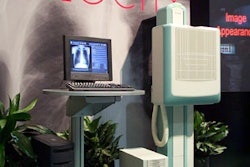VIENNA - A persistent drawback of MR angiography has been its inability to assess blood flow through metallic stents. But German researchers deploying copper-based stents and a modified acquisition technique have produced excellent visualization of blood flow in the stented coronary arteries of animals.
At today’s coronary imaging sessions of the European Congress of Radiology, Dr. Arno Buecker from the University of Aachen in Germany discussed a study that imaged blood flow through hand-woven, mechanically woven, and lasered metallic stents with MRA. All of the prototype stents (Aachen Resonance, Aachen Germany) were made of an alloy primarily consisting of copper.
"The primary MR sequence we used has been used in many publications as well as multicenter trials for many groups," Buecker said, noting a relatively long TE of 2 ms, and the importance of echo time to the technique. T2-weighted images were acquired using TR 7.2 ms, TE 2 ms, flip angle 30º, slice thickness 1.5 mm, acquisition window of 300 ms, spatial resolution of 0.7 x 1 x 1.5 mm, navigator-gated free breathing.
The images were acquired on a 1.5-tesla Intera scanner (Philips Medical Systems, Andover, MA) using a five-element Synergy cardiac coil. Stents (hand-woven, mechanically woven, and lasered) had been placed in the coronary arteries of 14 pigs (average 49 kg) before MRI.
Two researchers working independently analyzed artifact behavior subjectively using a three-point scale. Then, signal-to-noise ratio was quantitatively analyzed in the stented region and compared to measurements at the proximal and distal ends of the stent, Buecker said. Finally, the group performed a paired bidirectional test and calculated the differences in signal-to-noise ratios between the stented and control regions.
Looking at the results, no artifact was visible in the MR images by either observer in any of the stent designs, Buecker said. Quantitatively, the signal-to-noise ratio in the stented region was 18.4 arbitrary units (SD 2.23) compared to 18.64 arbitrary units (SD 2.36) outside the stents, "confirming our subjective impressions of these stents independent of the design we used," Buecker said. Paired bidirectional T-testing yielded a value of 0.00064.
"Artifact-free coronary MRA is possible in the presence of metallic coronary stents if you pay attention to stent design, and use a special dedicated MR alloy. Of course, just to get a glimpse of the future, what we would like to do is not only look at the lumen, but also look at the vessel wall, look at different imaging sequences," and assess performance independently of the imaging sequence.
Of course, invisible stents are hard to locate, Buecker said in response to a question from the audience. There are many ways to tweak the acquisition parameters to make the stents visible, he said, but it is very difficult to create a technique that makes the stent barely visible without inhibiting visualization of blood flow.
By Eric Barnes
AuntMinnie.com staff writer
March 9, 2003
Copyright © 2003 AuntMinnie.com



















